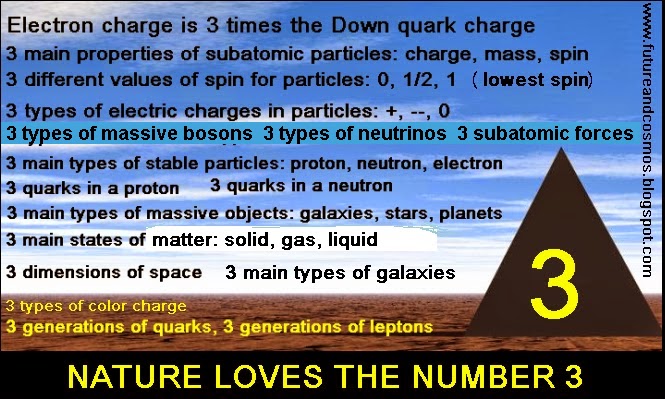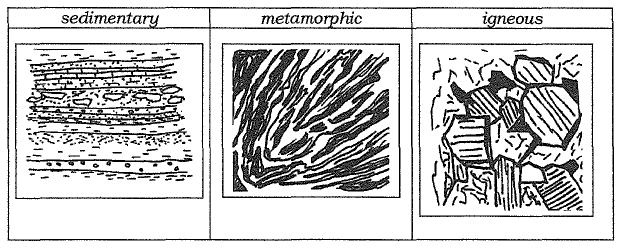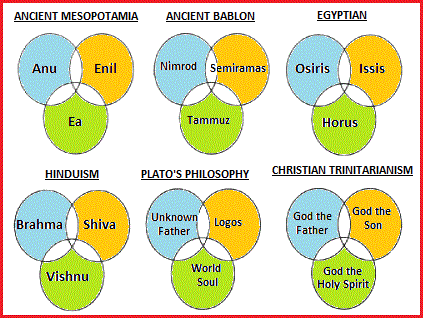page 2
~ The Study of Threes ~
http://threesology.org
Visitors as of 4/06/2023
| The Triplet Code 1 | The Triplet Code 2 | The Triplet Code 3 | The Triplet Code 4 |
(Continued from page 1.)
By taking a visual tour of number-related sounds and compile a list as Stephen Chrisomalis has done on his The Phrontistery: Numerical Prefixes page, we see a limitation in our human cognitive stream of identification by using repetition, just as there is in infant babbling as described on the Language 3's page 1. In addition, we should note the usage of word references for 7, 8, 9, 10 that would have a parallel account in today's usage of the months except that Septem-ber and the rest are two months off in count (though in an older ten-month calendar amongst the Romans made them correct). (In other words, September is the seventh month in the old calendar and not the ninth as we of today practice time and date keeping.)
| Numeral | Prefix | Base | Relation | Music | Multiple | Yearly | Sides | Exponent | |
|---|---|---|---|---|---|---|---|---|---|
| 1 | unus | uni | N/A | unary | (solo) | (single) | (annual) | unilateral | (million) |
| 2 | duo | bi/duo | binal | binary | duet | duple/double | biennial | bilateral | billion |
| 3 | tres, tria | tri | trial, tertial | trinary, ternary | trio | triple/treble | triennial | trilateral | trillion |
| 4 | quattuor | quadri/quart | quartal | quaternary | quartet | quadruple | quadriennial | quadrilateral | quadrillion |
| 5 | quinque | quinque/quint | quintal | quinary, quinquenary |
quintet | quintuple | quinquennial | quinquelateral | quintillion |
| 6 | sex | sex(t), se | sextal | senary/sexenary | sextet | sextuple | sexennial | *sexilateral | sextillion |
| 7 | septem | sept | septimal | septenary | septet | septuple | septennial | septilateral | septillion |
| 8 | octo | oct | octal, octaval | octonary | octet | octuple | octennial | octilateral | octillion |
| 9 | novem | nonus/novem | nonal | nonary | nonet | nonuple, noncuple |
novennial | *nonilateral | nonillion |
| 10 | decem | dec(a), de | decimal | denary | dectet | decuple | decennial | *decilateral | decillion |
| 11 | undecim | undec, unde | undecimal | undenary | *undectet | *undecuple | undecennial | *undecilateral | undecillion |
| 12 | duodecim | duodec, duode | duodecimal | duodenary | *duodectet | duodecuple | duodecennial | *duodecilateral | duodecillion |
So far, so good. We can see that there are a few exceptions to the general rule, particularly for the numbers 1 and 2, and in some cases such as "quinary / quinquenary" where multiple forms exist. Since I'm not being hardline about "proper" forms, I'm including all the forms normally used, even when they don't strictly follow the rules. Up to 12, the Latin prefixes hold up pretty well; most of the forms exist; only "sexilateral", of all the hypotheticals, is less than nine. My theory is that it sounds too lewd to have been adopted as the term for something with six sides. Well enough, then.
| Numeral | Prefix | Polygon | Polyhedron | Angle | Ruler | Meter | Group | Event | |
|---|---|---|---|---|---|---|---|---|---|
| 1 | en | mono | N/A | N/A | N/A | monarch | N/A | monad | N/A |
| 2 | dyo/duo/di | di/dy | N/A | N/A | N/A | diarch, dyarch | dimeter | dyad | biathlon |
| 3 | treis, tria | tri | triangle | N/A | triangle | triarch | trimeter | triad | triathlon |
| 4 | tessera | tetra | tetragon | tetrahedron | quadrangle | tetrarch | tetrameter | tetrad | tetrathlon |
| 5 | pente | penta | pentagon | pentahedron | pentangle | pentarch | pentameter | pentad | pentathlon |
| 6 | hexa | hex | hexagon | hexahedron | hexangle | hexarch | hexameter | hexad | *hexathlon |
| 7 | hepta | hept | heptagon | heptahedron | heptangle | heptarch | heptameter | heptad | heptathlon |
| 8 | okto | oct | octagon | octohedron | octangle | octarch | octameter | octad | *octathlon |
| 9 | ennea | ennea | enneagon, nonagon |
enneahedron | *enneangle | *ennearch | *enneameter | ennead | *enneathlon |
| 10 | deka | dec(a) | decagon | decahedron | decangle | decarch | decameter | decad(e) | decathlon |
| 11 | hendeka | hendec(a) | hendecagon, undecagon |
hendecahedron | *hendecangle | hendecarch | *hendecameter | *hendecad | *hendecathlon |
| 12 | dodeka | dodec(a) | dodecagon | dodecahedron | *dodecangle | dodecarch | *dodecameter | dodecad(e) | *dodecathlon |
The situation with the Greek terms is a little more complex than with the Latin, but not excessively so. Latin prefixes are used for some words for polygons, although the Greek prefix is to be preferred. "Biathlon" should, by all rights, be "diathlon", "triangle" is used for a plane figure as well as angles (instead of 'triagon'), and there are very few terms for 1 and 2. Of course, this is partly because there's no such thing as a two-faced polyhedron, and not much point in describing a single athletic event as a "monathlon" ...
So far, we've stuck to the numbers 1 through 12. We have pretty solid sequences of words, although the words relating to 9 and 11 are, to be fair, extremely rare. But moving to the teens, decades, 100 and 1000, the words become much more sparse. Still, given the right adjectives and a little creativity, we can construct many hypothetical words that should be understandable. Table 3 lists the higher Latin numbers and prefixes. I'll stick to listing the numerical bases and adjectives of relation, and let you figure out the rest on your own, on the pattern described above. Most of the other terms aren't found in dictionaries (how often do you need to describe something that recurs every 60 years?), with the exception of those for 20, where terms like vicennial and vigintillion are sometimes used.
A reference from an old book that I have used in the past provides an additional reference to the 3-to-1 ratio idea within the domain of biology:
|
Mendelian inheritance is usually described as the process by which one of two alternate alleles of a gene is inherited from each parent so that the offspring has one of the following combinations: two dominant alleles, two recessive alleles, or one of each. If both parents are heterozygous, that is, have one of each allele, the three genotypes will occur among the offspring with the following probabilities:
Phenotypically the two heterozygotes will be indistinguishable from the homozygous dominant. This results in the
famous 3:1 ratio James C. King, The Biology of Race, 1981, page 28) |
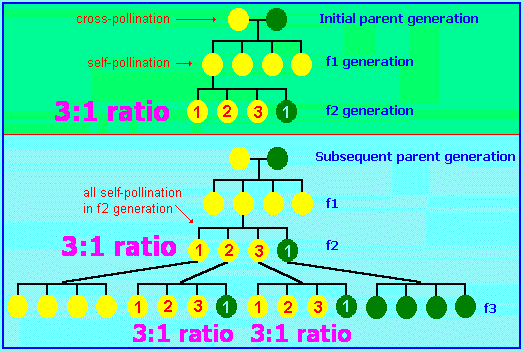
Source: Let's Talk Peace page 14
The "three to one" ratio idea appears to reference itself with the usage of a dichotomy, as if we are cognitively repeating an earlier sequence of counting. It gives the impression of being an even/odd distinction, though numbers begin with an odd "1", unless we consider "0" to be even and we start with it. Such a reference may lead some readers to think about computer programming and the usage of the basic "zeroes and ones" used as designators for the electron-based off/on sequencings (switching) which are occurring at faster and faster speeds, but have been noted as being limited and will require that we proceed from a bi-nomial configuration to a tri-nomial format.
 |
 |
 |
The images represent increasing speeds of switching which have taken place in computer processing. While actual speeds are much faster, the images are ideally illustrative to make the additional point that the supposed "two" part switching becomes an almost indiscernible singularity. And though most readers may well focus on the "two" aided by the words on/off and 0/1, we must ask where the on and off states begin. That is, is there no 3rd "middle" state that is neither on or off? Or is the "middle ground" between the transition a type of terrain where off and on exist as one... or an actual territory whether neither occur... thus a third "moment" exists... whether we view it as negligible or not. Source for the slow, medium, fast switches: Artificial Intelligence Series: Introduction | ||

Permit me to digress a moment into another subject area where the odd/even (paired) idea is valued as an applicable hypothesis in the Star Trek series of films, because when comparing larger sets of data from as many subject areas as we can, particular patterns that we symbolically label tend to show certain numbers coming up again and again, and that overall... there is a conservation of number usage (though words, phrases, sentences, paragraphs, etc... may be used in some cases), which we need to identify the reason(s) for since these quantities and patterns may change as the environment we live in continues to degrade. A change in them will give us an indication in the rate and type of disintegration. Indeed, is it possible to identify an ongoing degradation of one, another, or all species? Is it a topic not being pursued behind the "paywalls" of those contributing to the Journal of Theoretical Biology or other areas of similarly focused research? Taking data from different subject areas unveils a greater sampling of human cognition. Limiting our research to one subject is just as silly as limiting ourselves to one number pattern, when all of them together are also a pattern we should be cognizant of.
Raw Scores
Scores from IMDB as of 29th January 2006.
| # | Title | Score |
|---|---|---|
| 1. | Motion Picture | 5.9 |
| 3. | Search for Spock | 6.3 |
| 5. | Final Frontier | 4.7 |
| 7. | Generations | 6.3 |
| 9. | Insurrection | 6.3 |
| 2. | Wrath of Khan | 7.6 |
| 4. | Voyage Home | 7.2 |
| 6. | Undiscovered Country | 7.0 |
| 8. | First Contact | 7.4 |
| 10. | Nemesis | 6.5 |
A Statistical "Proof" of the Odd/Even Star Trek Movie Rule
At present, the binomial (0's and 1's) as a set of arbitrarily assigned symbols... are being accentuated with a tripartite boolean logic. It is an artificial means of increasing the value of "two" for which many have already recognized as having limitations. A new generation of computing 'based' on a set-of-three symbols is at present thought to require an application of quantum mechanics because it affords the presence of "threes". Instead of the word "trinary" computing to go along with "binary" computing, the word "ternary" is used. In short, the transition for a "two" to a "three" mindset is the present orientation of humanity due to the primivity of our brain's evolution. It is a struggle that has a long history as noted in the caption following the two example images on boolean logic:
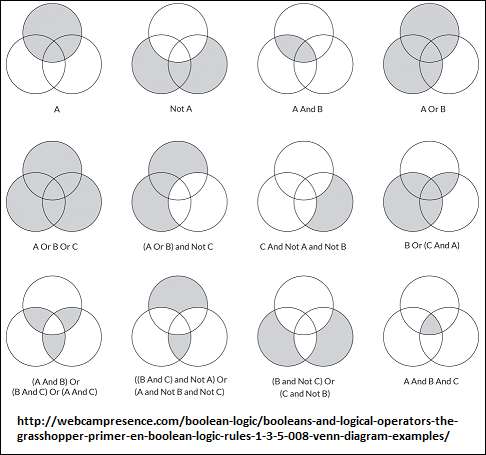 |

|
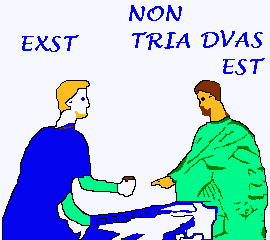 Roman dicers from a fresco at Pompeii, playing what is thought to be an early version of backgammon. The cartoon-like captions above their heads describe a disputed call: the man on the left cries, "I've won!" while the one on the right objects, claiming, "It's not a three, it's a two." Analogously, the two characters can be viewed as the right & left hemispheres of the brain. The right adamantly refuses to acknowledge the left's claim to a 3 and insists that the "3" the left sees is actually a 2. If the overall purpose of the "game" (life) is to achieve a "3" and yet there is a claim from some for a preponderance of "2" (with all its various guises), do we try to change the rules of the "game" or create a teaching methodology which enables the distinctions of "2" and "3" to be made identifiable and useful from all vantage points? (Even if the purpose of the game is defined by Earth-specific environmental circumstances.) The social problems created by an underlying 2 versus 3 contention has been going on for long enough... since Pompeii anyway. Let's not leave a similar picture of us for future historians who find it beneath the rubble of an extinct civilization. |
|
Here's an additional reference to transistor counts: Wikipedia: Transistor Count
Typical logic gate categories:
- Dual Gate
- Quad Gate
- Single Gate
- Triple Gate
The human mind continues to grapple with small numbers... with a conservation of number, even if the small numbers are multiplied exponentially. The exponential results are often quantified into bite-size (or byte-size) bits. Again, if this conservation of number is due to an environmentally-based physiological predisposition for the sake of a survival necessary equilibrium in incrementally deteriorating conditions, we must come to recognize how fast, by what means, and to what extent the deterioration is taking place since this will effect what is or is not produced in our theories and applications thereof.
Here are a few examples of "triplet structures" you may or may not be familiar with:
- Earth is the 3rd planet from the Sun
- 3 in atomic particle configurations: Proton- Neutron- Electron
- 3 Basic rock formations: Igneous- Metamorphic- Sedimentary
- 3 key processes of the rock cycle: crystallization, erosion and sedimentation, and metamorphism (Rock Cycle Processes)
- 3 to 1 ratio perspective of rock cycle processes (involving the three types or classes of rock):
- Sedimentation which produces sediments
- Lithification which produces sedimentary bedrock
- Metamorphism which produces metamorphic bedrock
- Melting and crystallization which produce igneous bedrock
- 3 to 1 ratio of basic geological processes using a dichotomous internal/external to Earth differentiation (3 internal/1 external):
- 3-to-1 ratio states of matter: (Solids- Liquids- Gases) + Plasma
- 3 sentence ending punctuations: Period- Question Mark- Exclamation Point
- 3 college degrees: Bachelor's- Master's- PhD
- 3 University Awards: Cum laude - Magna cum laude - Summa cum laude (Threes Poster column 5)
- Various religious trinities exist
- 3 to 1 ratio of the four gospels: (Matthew, Mark and Luke are called the synoptic gospels and John is idiosyncratic.)
- Various philosophy trinities exist
|
Thesis ~ Antithesis ~ Synthesis Indulgence ~ "Middle Way" ~ Ascetism Major Premise ~ Minor Premise ~ Conclusion Contradiction ~ Excluded Middle ~ Identity Principal | ||
| "God-ology": Omnipresent Omnipotent Omniscient |
"Metaphysics-ology": What is real How change comes What is mind |
Marxian "Dialectology": Unity of opposites Quantity & quality Negation of negation |
| Epistemology: How we know What is truth What is mind |
Axiology: Nature of good Nature of beautiful Nature of religious |
Ontology: Quality (1st-ness) Relation (2nd-ness) Representation (3rd-ness) |
Threes poster column 5
Let's Talk Seriously About Peace page 7
Page Originated: Saturday, 7th April 2018... 7:53 AM
Initial Posting: Thursday, 12th April 2018... 10:57 AM
Updated Posting: Saturday, 22nd June 2019... 8:30 AM
